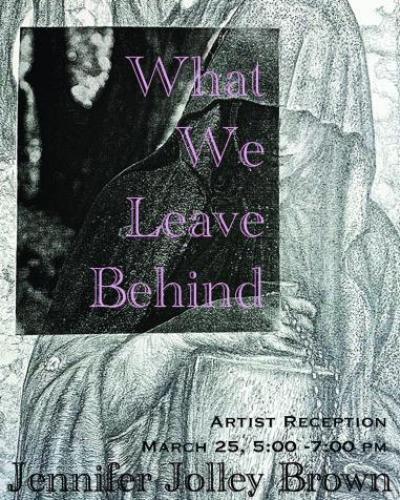

What We Leave Behind , a new art exhibit by artist Jennifer Jolley Brown, has opened in the Wilkes Gallery at Ohio University Lancaster.
Brown earned a bachelor’s degree in arts and sciences and returned to graduate school to obtain a master of arts in liberal studies. She said that graduate school stoked her creativity when she began taking ceramics classes at the Columbus Cultural Arts Center. The Center also held a printmaking workshop which Brown attended.
“I was fascinated by printmaking and kept doing it through the Center for a number of years.,” Brown said. “Now, I am one of the printmaking instructors there and have the joy of introducing adult students to this medium. Some of them have no idea what “printmaking” is on day one. I have students who try it for a session or two and move on to other things; others stay with it for years.”
Brown’s current artistic practice is focused on printmaking and ceramics, which you will find on display in What We Leave Behind. She exhibits in both mediums as a member artist at Studios on High Gallery in Columbus, Ohio.
She said she is drawn to dry point etchings on acrylic and enjoys combining them with other techniques. She also creates photopolymer gravure prints using light-sensitive metal plates (developed in plain water) and her own photographs and original drawings.
“My ceramics include hand-built, slab constructed, and wheel-thrown vessels and sculptures. I find hand-building to be meditative and will go to that process when I need to be in my happy place. I enjoy working with different vessel shapes, and my pieces range from very contemporary-looking, to traditional, to whimsical.”
What We Leave Behind is now open for viewing to the public in the Wilkes Gallery at Ohio University Lancaster. The gallery is open from 9 am to 5 pm. An artist reception will be held March 25 from 5 pm to 7 pm.
Learn more about Brown’s inspiration for What We Leave Behind in the artist’s own words below.
“What We Leave Behind”
What do we leave behind? Relics from our younger selves, things handed down through families, places and vehicles that were once part of our daily lives. Less romantically, we leave behind stuff. Some of it is garbage, destined for landfills. Perhaps we recycle a portion of what we can. Those are a few tangible things. What we leave behind says a lot about us as humans, individually and collectively.
I am drawn to things and places that are time-worn, especially those that imply an interesting story. I wonder who cared for them, to whom they were important, what they looked like in their prime, and how things came to be the way they are now. These often become the subjects and inspiration for my imagination and my art. Wherever I travel, whether close to home or far away, I seek these things out. My goal is to elevate them in a way that feels appropriate – they are worthy of notice and often beautiful in their decline or disrepair. The theme of this exhibit is represented in a fairly obvious manner in the subjects featured in the prints and mixed media work. The ceramics are connected to the theme through process and sometimes through form. For these pieces, I have used found objects, secondhand doilies and military insignia, discarded railroad, spikes and horse hair, to name a few, to create physical and visual texture. The raku- and saggar-firing processes are ancient, and the ceramics in this exhibit include contemporary forms and “modern relics.”
The methods and materials I use to create my art also speak to what we leave behind. In our time, we have non-toxic and less-toxic printmaking processes, which are friendlier to artists and the environment. I use soy-based printmaking inks that clean up with plain soap and water, a UV light-based process to etch images on metal plates which are “developed” with plain water, and sheets of acrylic and acetate used as packaging or protection for other items for drypoint etchings. The ceramics in this exhibit are raku-fired or saggar-fired, and I use newspapers, sawdust, straw, and other organic material such as leaves and pine needles as part of those firing processes.

